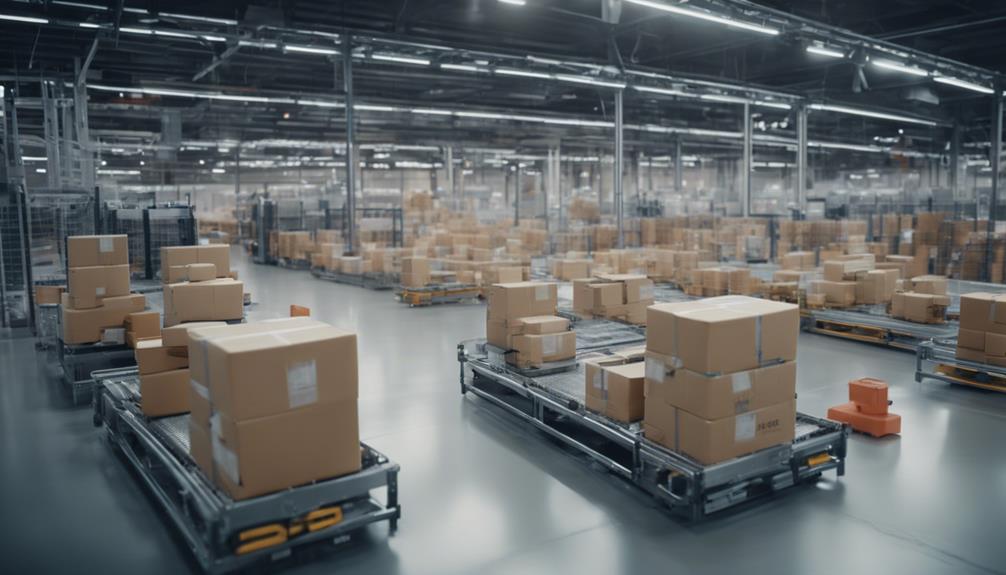I drive a competitive edge with business automation by streamlining operations and boosting efficiency. Automation tools reduce manual errors, allowing me to focus on strategic activities and cost savings. With data-driven insights, I optimize decision-making and anticipate market trends. Predictive analytics helps forecast customer behaviors, enhancing marketing strategies and supply chain performance. Personalized services, powered by automation, increase customer satisfaction and retention. By reallocating resources and leveraging advanced AI algorithms, I optimize processes and stay ahead of market demands. If you explore further, you'll uncover how to harness these automation strategies for sustained success.
Key Takeaways
- Automation eliminates inefficiencies and manual errors, boosting productivity and accuracy.
- Predictive analytics enable proactive decision-making by forecasting customer behaviors and market trends.
- AI algorithms provide real-time data insights, enhancing strategic decision-making and market positioning.
- Workflow automation reallocates resources effectively, leading to significant cost savings and operational efficiency.
- Personalized customer experiences enhance satisfaction and loyalty, driving higher engagement and retention rates.
Streamlining Operations
By leveraging automation, businesses can streamline operations, eliminate inefficiencies, and greatly boost productivity. I've seen how automated data entry, inventory management, and order processing enhance accuracy and efficiency.
By integrating automation into our business processes, we achieve faster turnaround times and significant cost reduction, which translates to an improved customer experience. Operational efficiency becomes a reality, as we save time and money, allowing us to outpace competitors.
Automation also provides the agility to quickly adapt to changing market conditions through automated data analysis and reporting. This strategic use of automation not only refines our operations but gives us a competitive edge, setting us apart in a rapidly evolving market landscape.
Enhancing Efficiency
Leveraging workflow automation tools like Asana, ClickUp, and Zapier, we can enhance our operational efficiency by reducing manual errors and speeding up business processes. By automating tasks and streamlining processes, these tools enable us to focus on strategic activities, achieving substantial cost savings.
Incorporating AI technology into our workflow automation allows us to optimize operations, adapt swiftly to changing market conditions, and outpace competitors. This not only gives us a competitive edge but also guarantees that our business remains agile and resilient.
The ability to automate tasks means we can reallocate resources more effectively, improving overall productivity and efficiency. In this fast-paced environment, staying ahead necessitates leveraging advanced tools for maximum operational efficiency.
Data-Driven Insights

When I harness data-driven insights through automation, I enhance decision making by quickly analyzing large data sets for accurate trends and patterns.
The power of predictive analytics allows me to anticipate market demands and personalize customer experiences.
With real-time data access, I can optimize processes and drive strategic growth.
Enhanced Decision Making
Through the integration of AI algorithms that swiftly process vast amounts of data, businesses can obtain precise insights for strategic decision-making. Leveraging these data-driven insights aids in:
- Market Trend Predictions: AI algorithms analyze patterns to forecast market shifts, enabling proactive responses to dynamic market conditions.
- Personalized Customer Experiences: Data analysis tailors interactions, anticipating customer needs and enhancing satisfaction.
- Strategic Planning: Informed decision-making relies on accurate insights, driving competitive advantage by staying ahead of market demands.
Predictive Analytics Power
Predictive analytics harness the power of data to accurately forecast customer behaviors, market trends, and essential risks, revolutionizing strategic business planning.
With AI-driven insights, I can optimize marketing strategies, ensuring my business stays ahead of market shifts.
Accurate demand forecasting allows me to enhance procurement efficiency and improve supply chain performance, vital for reducing costs and increasing operational efficiencies.
By leveraging predictive analytics, I'm not just making informed decisions; I'm strategically positioning my business for sustained success.
The data-driven insights gained enable me to anticipate changes, respond proactively, and maintain a competitive edge in a dynamic market.
Ultimately, predictive analytics drive business success by transforming raw data into actionable, strategic intelligence.
Real-Time Data Access
Building on the power of predictive analytics, real-time data access provides immediate insights that allow me to make swift, informed decisions, enhancing business agility and responsiveness. This capability is essential for staying ahead in a competitive landscape. With real-time data, I can analyze current trends and patterns, ensuring that my strategic planning is both timely and precise. This agility allows for rapid adjustments, giving me a competitive advantage.
Key benefits of real-time data access:
- Informed Decisions: With instant data, I can make decisions based on the most current information.
- Agility and Responsiveness: Quick access to data enhances my ability to respond to market changes.
- Strategic Planning: Understanding trends and patterns guarantees my strategies are always relevant.
Real-time data access is indispensable for maintaining a competitive edge.
Customer Experience
When I streamline service processes with automation, I can create personalized interaction strategies that boost customer satisfaction.
Intelligent automation technologies like NLP and RPA allow for responsive and tailored experiences without altering existing systems.
This not only enhances our competitive edge but also frees up employees to focus on delivering exceptional service.
Streamlined Service Processes
Streamlining service processes through automation greatly reduces costs and boosts efficiency in customer interactions. By automating processes, I've seen 15-20% cost savings and 30-50% efficiency gains. Importantly, 90% of customers seek immediate responses, making response times essential.
Here's how automation enhances customer experiences:
- Immediate responses: Automation caters to the demand for prompt replies, greatly improving customer satisfaction and retention.
- Personalized experiences: Tailored interactions drive revenue growth, with 80% of consumers preferring brands that personalize their services.
- Cost savings: Efficient processes cut costs while ensuring higher customer satisfaction and 20-30% increased retention rates.
These efficiency gains and optimized interactions position businesses to outperform competitors by 80% in revenue growth, proving automation's strategic value.
Personalized Interaction Strategies
By leveraging automation, we can craft personalized interaction strategies that greatly enhance customer experience and drive measurable business outcomes. Automation allows us to deliver tailored recommendations, resulting in a 25% boost in customer loyalty.
This precision in interaction doesn't just stop at satisfaction; it translates into a 30% increase in repeat purchases. Enhanced customer experiences fostered through personalized automation strategies directly contribute to a 15% growth in revenue.
Moreover, companies that embrace these strategies outperform competitors by 10% in customer retention. The integration of automation into personalized interaction strategies not only elevates customer satisfaction but also secures a competitive edge, ensuring sustained revenue growth and stronger customer relationships.
The future of customer engagement lies in personalized automation strategies.
Supply Chain Optimization

Leveraging AI for supply chain optimization delivers significant cost savings and operational efficiencies. By integrating AI, I can harness predictive analytics to revolutionize inventory management, cutting inventory costs by 20%.
Automation streamlines processes, reducing lead times by up to 40%, boosting overall efficiency. Additionally, AI enhances delivery performance by 50%, ensuring timely deliveries. Identifying bottlenecks becomes seamless, improving productivity by up to 30%.
Here's a concise breakdown of benefits:
- Cost Reduction: AI-driven supply chain optimization leads to a 5-10% reduction in supply chain costs.
- Efficiency Gains: Automation reduces lead times by 40%, enhancing operational efficiency.
- Performance Improvement: AI improves delivery performance by 50%, elevating service levels.
These innovations are essential for maintaining a competitive edge in today's dynamic market.
Predictive Analytics
Harnessing historical data and advanced machine learning algorithms, predictive analytics empowers businesses to forecast future trends and outcomes with remarkable accuracy. By leveraging predictive analytics, I can anticipate customer behaviors, market changes, and demand fluctuations. This enables proactive decisions, optimizing resource allocation, and improving operational efficiencies.
Here's how predictive analytics impacts key areas:
| Key Area | Benefit | Outcome |
|---|---|---|
| Customer Insights | Anticipate behaviors | Personalized engagement |
| Resource Management | Optimize allocation | Cost reduction |
| Operational Efficiency | Improve processes | Enhanced productivity |
| Strategic Planning | Data-driven insights | Competitive edge |
Personalized Services

Building on the predictive power of analytics, personalized services driven by automation greatly enhance revenue and customer satisfaction through tailored recommendations and experiences. By leveraging automation, I can offer precise cross-selling and upselling opportunities, leading to a 20% increase in these areas.
Additionally, 80% of customers are more likely to engage with brands that provide personalized services, boosting customer retention rates by 6-10%.
Here's how automation impacts business:
- Revenue Increase: Automation facilitates a 10-15% rise in revenue through targeted personalization.
- Customer Lifetime Value: Personalized services foster a 20% increase in customer lifetime value and loyalty.
- Customer Retention: Enhanced engagement through automation results in higher customer retention rates.
Strategically harnessing automation for personalized services positions businesses for sustained growth and innovation.
Frequently Asked Questions
What Provides a Competitive Edge to a Business?
I believe a competitive edge comes from market differentiation, customer loyalty, and brand reputation. By leveraging unique selling points, conducting market analysis, offering competitive pricing, and focusing on customer service, innovation strategies, growth potential, and strategic partnerships, success follows.
How Does Automation Improve Competitiveness?
You might think automation's expensive, but it enhances process efficiency, reduces errors, and saves costs. It optimizes workforce, boosts customer satisfaction with faster turnaround, guarantees data accuracy, supports decisions, allocates resources smartly, and integrates workflows seamlessly.
What Is the Competitive Edge in a Business Plan?
The competitive edge in a business plan involves market analysis, unique selling propositions, and customer insights. Strategic partnerships, product differentiation, brand loyalty, cost leadership, sustainable practices, market segmentation, and visionary leadership all play essential roles in ensuring long-term success.
Why Would a Business Choose to Use Automation?
When push comes to shove, I'd choose automation for its cost savings, error reduction, and employee efficiency. It boosts customer satisfaction, data accuracy, and scalability while ensuring process consistency, operational speed, resource optimization, and market agility.
Why Does Technology Provide a Competitive Edge?
Technology provides a competitive edge through operational efficiency, cost reduction, and market agility. Workflow automation optimizes processes, reduces human error, and enhances decision-making. Real-time insights improve resource allocation and customer satisfaction, driving strategic innovation.
Conclusion
In the cutthroat world of business, automation isn't just a tool—it's a game-changer. By streamlining operations, enhancing efficiency, and leveraging data-driven insights, I've turned chaos into a well-oiled machine.
The ability to predict trends and personalize services has been my competitive edge, transforming my supply chain into a finely tuned orchestra. Automation has empowered me to not just keep up but lead the charge, making every process sing in harmony.





